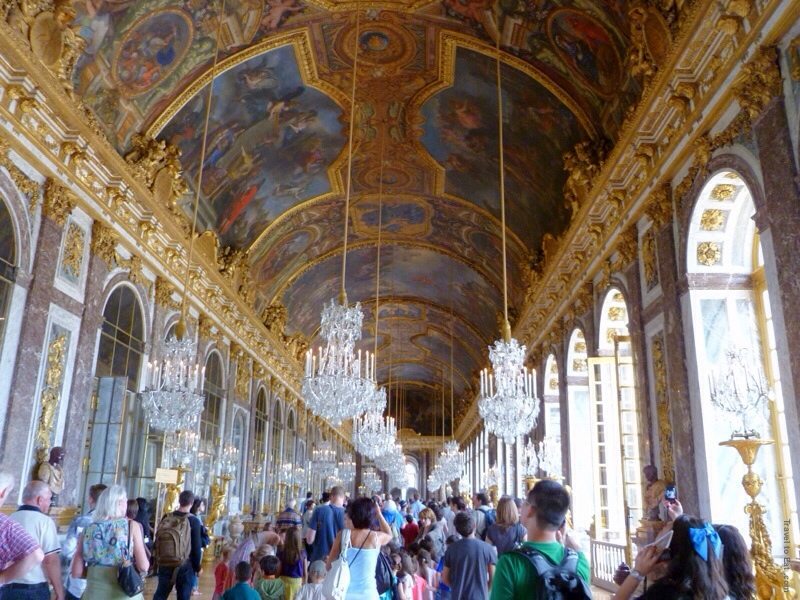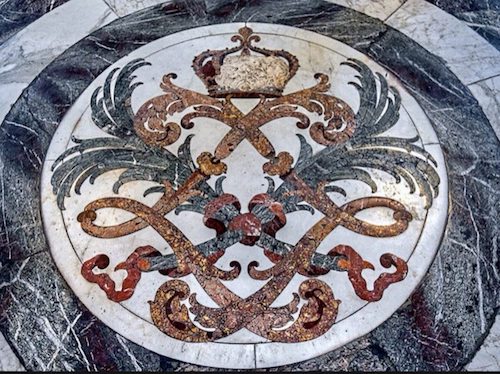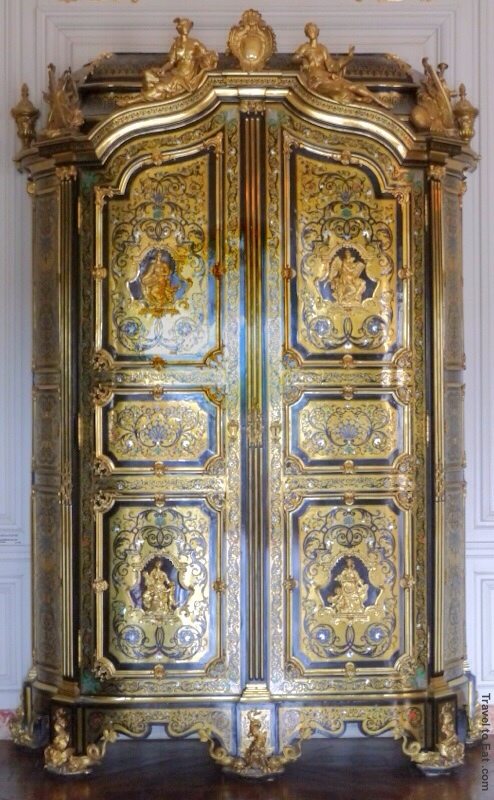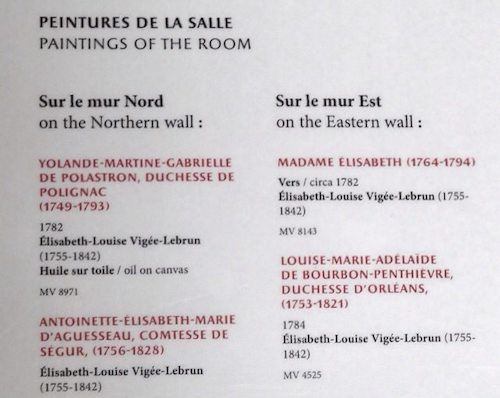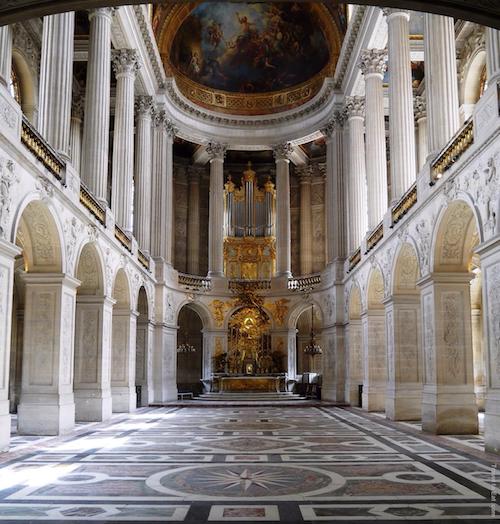
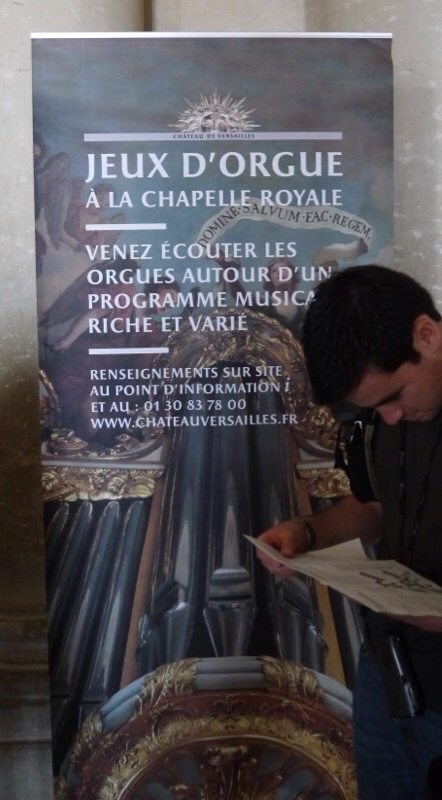
This is the interior of the Royal Chapel at the Palace of Versailes. Begun in 1689, construction was halted due to the War of the League of Augsburg; Jules Hardouin-Mansart resumed construction in 1699. Hardouin-Mansart continued working on the project until his death in 1708, at which time his brother-in-law, Robert de Cotte, finished the project. The marble floor is beautiful and to my eye the chapel has a very modern feel, not as much ostentatious gilt as the rest of Versailles. Dedicated to Saint Louis, patron saint of the Bourbons, the chapel was consecrated in 1710. Louis XVI and Marie Antoinette were married here. The chapel was de-consecrated in the 19th century and has since served as a venue for state and private events. Musical concerts are often held in the chapel of Versailles as seen to the right.
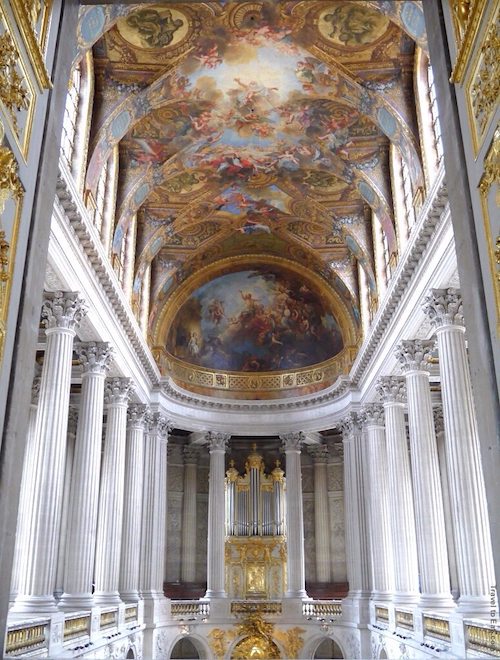
Here is the view from the second floor. The ceiling of the nave represents “God the Father in His Glory Bringing to the World the Promise of Redemption” and was painted by Antoine Coypel; the half-dome of the apse is decorated with Charles de la Fosse’s “The Resurrection of Christ”. From this view, the Corinthian columns along with the half dome gives us a distinctly non-French cathedral, looking like it would be much more comfortable in Italy. The beautiful period organ case made by Philippe Bertrand (designed by Robert de Cotte) dates from 1710. The royal family was upstairs, the courtiers were downstairs and the women were in the gallery side-chapels. The choir and the musicians stood around the organ.
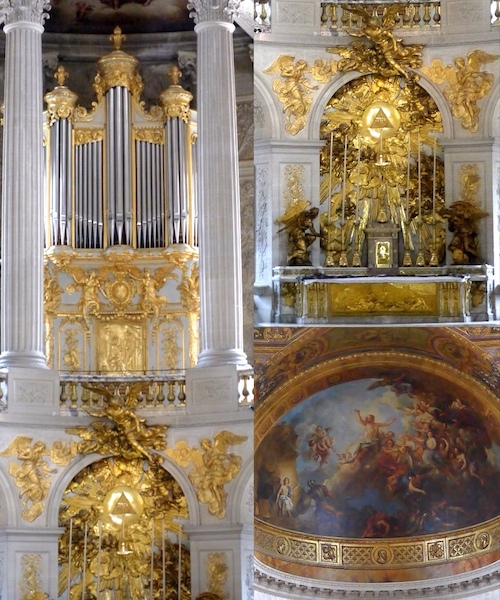
Here is a closeup of the organ, alter and half-dome. We were not allowed to actually enter the chapel so these closeups are the best I could do. I have been in several hundred chapels, cathedrals and churches in the course of my travels and I have never seen one without a prominent cross. Instead we see a prominent sun with the rays extending from a triangle with Hebrew lettering.
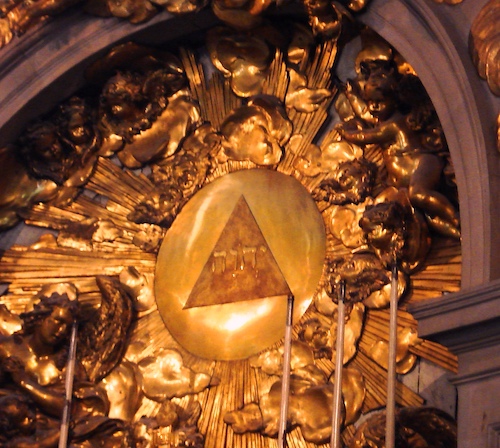

The lettering shown above is the Tetragrammaton, or the Hebrew word for God (YHYH or Yahweh), never said aloud or written by observant Jews. The triangle is significant since two triangles together form the “Star of David”. There are 72 names for God in Hebrew but the most common spoken and written are Adonai (an acceptable shorthand for God) and Elohim. Hebrew differs from Greek and other modern languages in that Hebrew has no vowels. Vowels are indicated by dots and dashes above and below the consonents. This example has the vowel points of “Elohim”. Elohim (?????????) is a grammatically singular or plural noun for “god” or “gods” in both modern and ancient Hebrew language. When used with singular verbs and adjectives elohim is usually singular, “god” or especially, the God. When used with plural verbs and adjectives elohim is usually plural, “gods” or “powers”. The superimposition of the Hebrew gods (plural) with the sun of Louis XIV seems to me to be significant. I have not found anything on this subject online, so I am going out on a limb, but I think this symbolism is intentional. Additional Hebrew symbolism is the presence of the four archangels surrounding a figure with a crown, presumable Louis XIV, above the Tetragrammaton. I will have a separate post to explore this subject further.
The crowned monogram of an interlaced double “L” alluding to Saint Louis and Louis XIV is at the foot of the stairs going up to the alter.
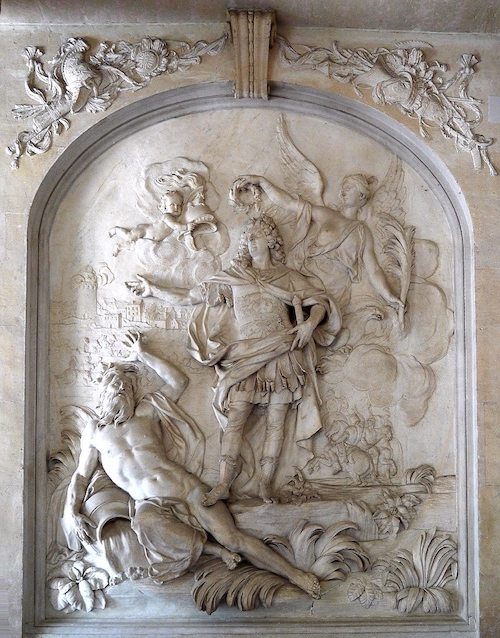
This is a bas-relief of Louis XIV in a Roman outfit in a vestibule outside the Royal Chapel. In planning the interior decorations at Versailles, the artists devised a scheme of ornamentation inspired by ancient Rome. Mythological and historical subjects were utilized for the glorification of the “Grand Monarch”. “A Description of the Château”, officially printed in 1674, gives us the key to the interpretation of the allegories. “As the Sun is the device of the King, and poets represent the Sun and Apollo as one, nothing exists in this superb dwelling that does not bear relation to the Sun divinity.” Thus there are many depictions of Louis XIV in Roman clothing in addition to sun motifs and his initials. At Versailles, the mood is distinctly Roman as opposed to later buildings, here I am thinking of the Palais Garnier (see my post), in which the mythology shifts to more of a Grecian influence. It is clear that subsequent French architecture and design came from the art and construction of the Palace of Versailles, at the time the most influential and opulent construction since the fall of the Roman Empire. This particular piece reminds me of “Diogenes and Alexander” by Pierre Puget (see my post). I think this is “Louis XIV Crossing the Rhine” by Nicolas and Guillaume Coustou.
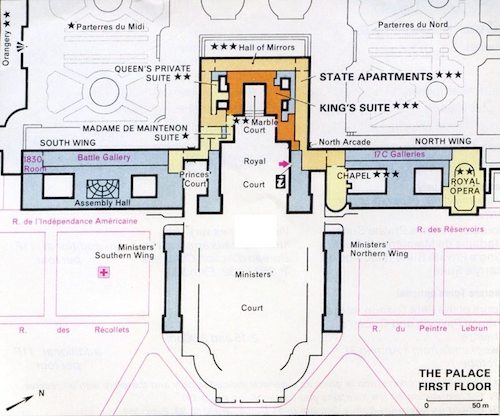
The self guided tour starts on the first level noted by the “i” in the map above. The ground floor was for the Dauphine and family and the rooms have been recreated as you will see below. You then go to the second floor, in France this is the first floor, where you see the Hercules room and the six state apartments, Abundance, Venus, Dianna, Mars, Mercury and Apollo. The Hall of Mirrors is flanked by the War and Peace rooms. Finally you see the Queen's apartments and leave by the famous Queen's staircase. If you take a guided tour, you also get to see the opera, the King's apartments and the Queen's private rooms. The palace gets hot and crowded in the morning, even on the guided tours, the only restaurant is at the end, Angelina's, by the Queen's or Marble Staircase. If you must visit when there is a long line, be sure to take water, no drinking fountains, break points or exits in the whole place.
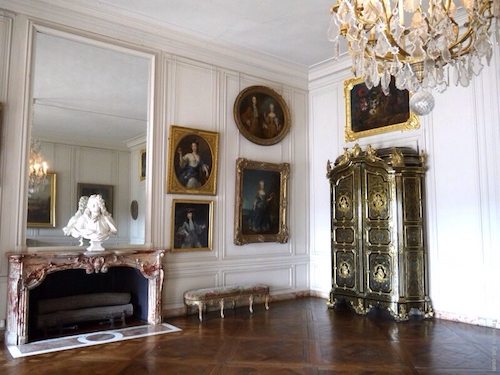
This is the second antechamber of the Dauphine. The fireplace of Queen Marie Leszczinska was carved in Sarrancolin Pyrenees marble in 1725 by Nicolas Montheon, Nicolas Barja and Charles Rousseau. It was dismantled and replaced for Marie Antoinette in 1786 and reinstalled in 1990. The white marble bust is of Phillipe Duc D'Orleans Regent of France (1674-1723) by Jean-Louis Lemoyne in 1715. The upholstered bench is rocaille style carved wood from the royal manufacturer La Savonnerie. The wardrobe is oak and walnut with ebony veneer, Boule tortoiseshell marquetry on copper backing with inlays of mother-of-pearl and horn with gilt bronzes attributed to Noel Gerard, early 18th century.

This is the Dauphine's bedroom. The bed is a canopy style Polish bed from 1758 made by Nicoulas Heurtaut. The two Bergère chairs are also 1758 by Nicoulas Heurtaut. A Bergère is an enclosed upholstered French armchair with an upholstered back and armrests on upholstered frames. The carpet was made from 1753-1757 from the workshop of Pierre-Charles Duvivier. Look carefully to the right and left of the bed and you will see almost invisible doors leading to a behind-the-scenes labyrinth of corridors and to chamber pots (no toilets).
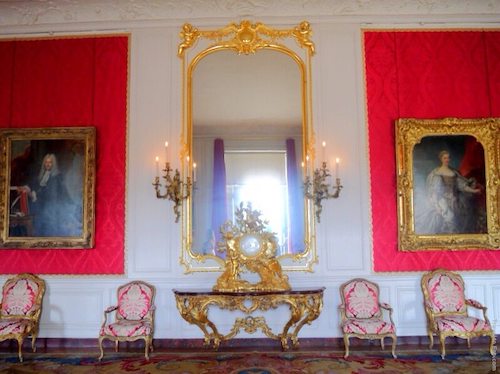
This is the large study of the Dauphine. The four straight backed women's chairs are also 1758 by Nicoulas Heurtaut. The two wall lamps are gilt bronze from 1750. The carved and gilt console table with red griotte marble top was made by Antoine Guesnon and Jacques Verberckt in 1747.


This is the inner study of the Dauphine. The “Lean-To Secretaire” and writing desk are mahogany veneer with amaranth and kingwood inlays and gilt bronze by Bernard II Van Risen Burgh (BVRB). They were delivered in 1745 and 1746 by the merchant-manufacurer Franc?ois He?bert for the private study of the first dauphine, Marie Thérèse Raphaëlle, Spanish Infante (non-inheriting daughter of the Spanish king). The four armchairs and Bergere are from 1750 with brocade from the factory of Lazarev or Sopojnikow in Moscow. The chandelier is from 1750, painted metal and Meissan porcelain.
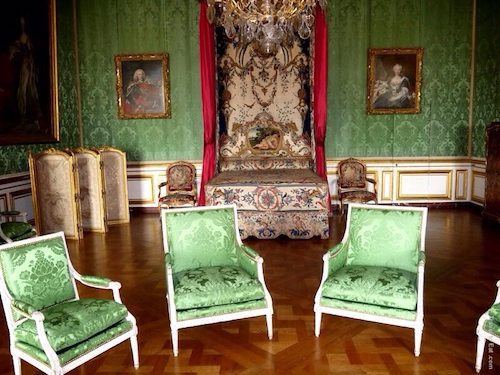
This is the Dauphin (this one is for the boys) bedroom. The canopy bed “A La Duchesse” with petite-point (Saint-Cyr) embroidery is from 1740. The two Bergers and green chairs in the foreground are from 1785 by Jean-Baptiste Boulard. They were commissioned by by Marie Antoinette in preparation for the birth of her son, the Duke of Normandy.

This is the Large Study of the Dauphin. The four paintings are listed to the left. The picture I took of the placard in this room did not turn out but the green fabric seems the same as the Dauphin bedroom above. This room also holds a fabulous globe which I will present in a different post.
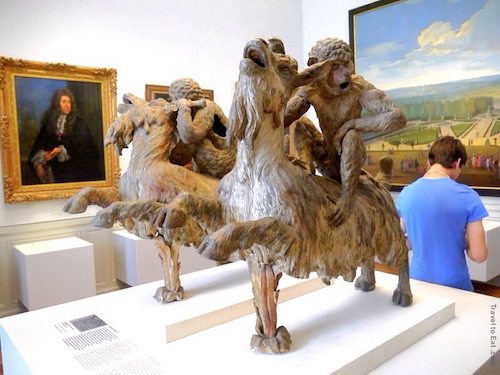

These monkeys are part of a series created for the “labyrinth”, laid out in 1672-1673, in the southern part of the gardens for the distraction of the children. This was dedicated to Aesop's Fables, the model for the French writer La Fontaine. Winding walks connected 39 fountains and 330 lead figures from the Fables, all of which were painted naturally. These were very fragile, expensive to maintain and were replaced by the Queen's grove in the 18th century.
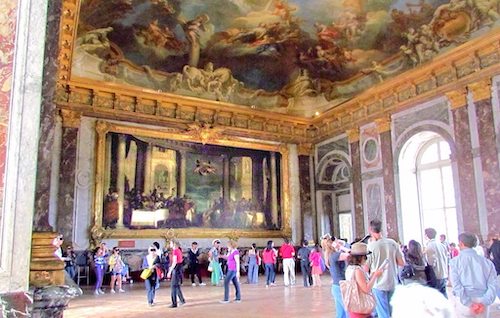
The Hercules room is the second largest room in the Palace. The room was built to house the painting by Paolo Veronese that hangs on the wall seen above, “Christ's Supper at the House of Simon”, painted for the refectory of the Servite Convent in Venice in 1570. In 1664, the Doge had presented it to Louis XIV so that the king would support him against the Turks. From 1682 onwards, the fourth chapel of the palace occupied its location over two floors and served until 1710, when it was replaced by the present chapel. This room was built between 1712 and 1736 by Robert de Cotte. It is remarkable by the decoration of the walls with marble of various colours and the many pilasters with the Corinthian style capitals of gilded bronze. If you look at the map, you can see that there are windows on both sides of the room, which makes it bright and airy.
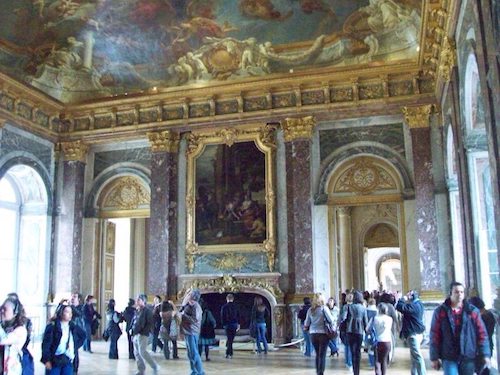
The marble fireplace is decorated with bronzes of Antoine Vassé evoking Hercules. Above the fireplace hangs a painting of Paolo Veronese “Rebecca and Eliézer”.
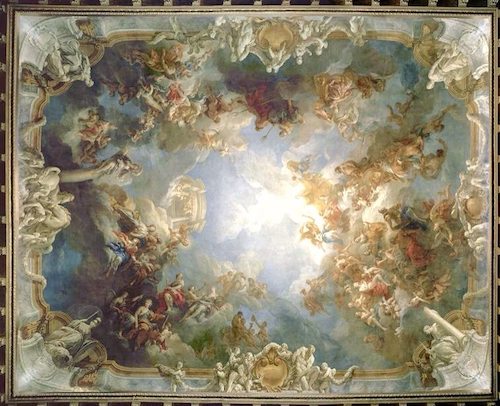
Interrupted due to the death of the Sun King for ten years, the works on the Hercules salon lasted until 1736, when François Lemoyne completed the painting of the vault depicting the Apotheosis of Hercules, which was supposed to show that “Virtue raises man above himself”. This vast allegorical composition with 142 figures aimed to rival the masterpieces of the Italian fresco painters but it was painted on primed canvases, i.e. glued onto the support. The painting shows Hercules being received into the company of the Olympian gods. Lemoyne, worked on this painting for three years, after which, in exhaustion and despair, he committed suicide. Hercules' face also appears on the fireplace. The Hercules Room is the entrance to the State Apartments.
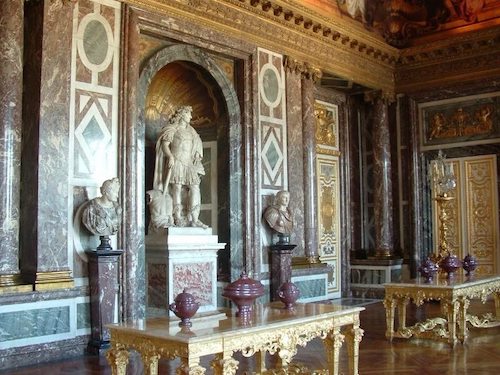

This is from the ceiling of the Venus room, “Venus Crowned by the Graces” by René-Antoine Houasse 1672.
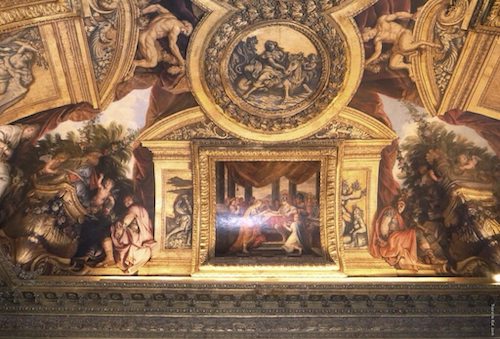
Here is more of the ceiling of the Venus Room.
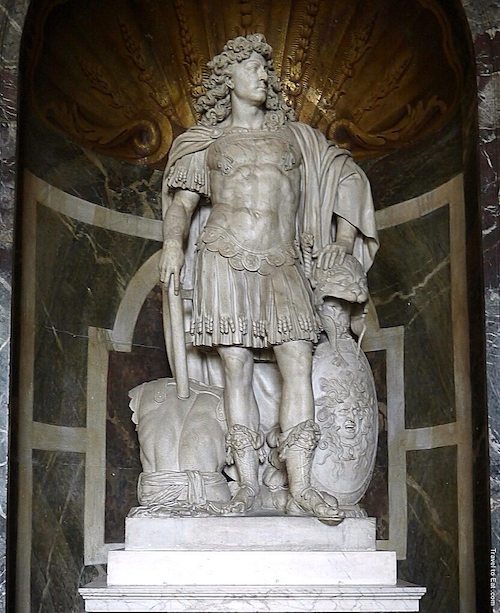
This is also from the Venus room, Louis XIV dressed as a gladiator by Jean Warin 1671. Again we see the Roman motif discussed above.
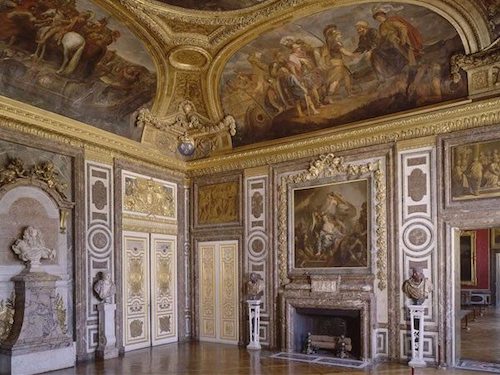
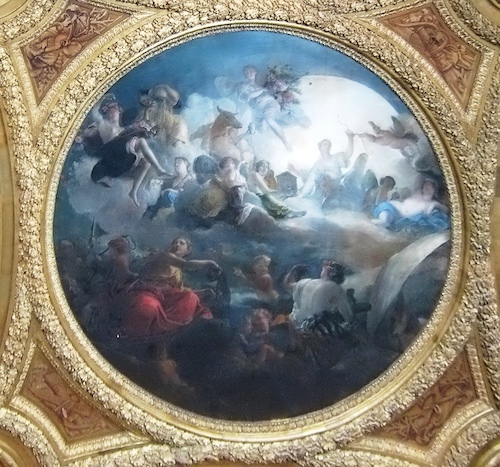
The ceiling was painted by Gabriel Blanchard, “Diana Presiding Over Hunting And Navigation”. In Greek Antiquity, Diana, the goddess of hunting, was associated with the moon due to her coldness. She was also the sister of Apollo, the Sun God. The mouldings are decorated with hunting scenes of heroes of the Antiquity. Here, the allusion is transparent because it is well known that Louis XIV was a great hunter.
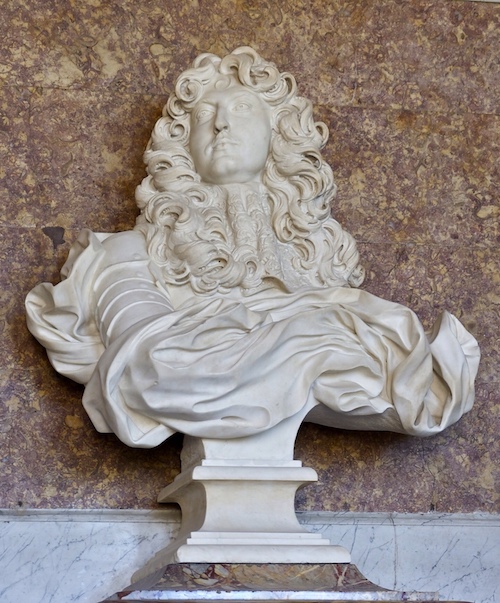
This bust of Louis XIV is in the Diana room by Gian Lorenzo Bernini from 1665. This is the same Bernini that built the piazza and colonnades in front of St. Peter's Basilica and did the interior decoration of the Basilica, and as we would expect, created a dreamy masterpiece with flowing locks and his eyes gazing upwards. Bernini revolutionized marble busts, lending glamorous dynamism and animation to the stony stillness of portraiture. At the end of April 1665, at the height of his fame and powers he travelled to Paris, where he remained until November. The sole work remaining from his time in Paris is this bust of Louis XIV, which set the standard for royal portraiture for a century.
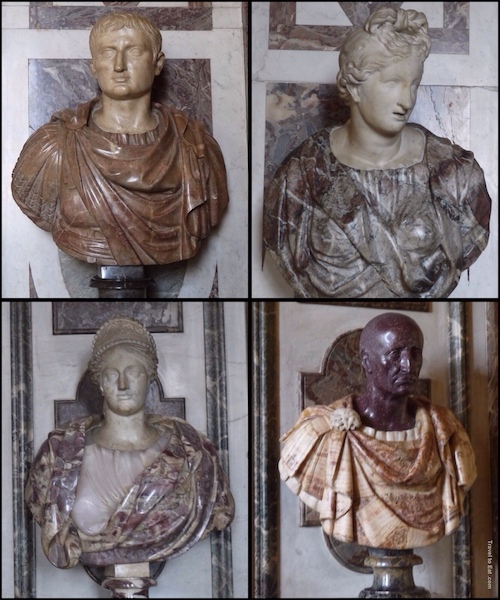
These marble busts in the Diana room must have been expensive, judging from the exotic marble. All are Roman figures from the past, even incorporating the porphyry favored by the Roman emperors.

A detail from the wall, with the “sun king” motif.
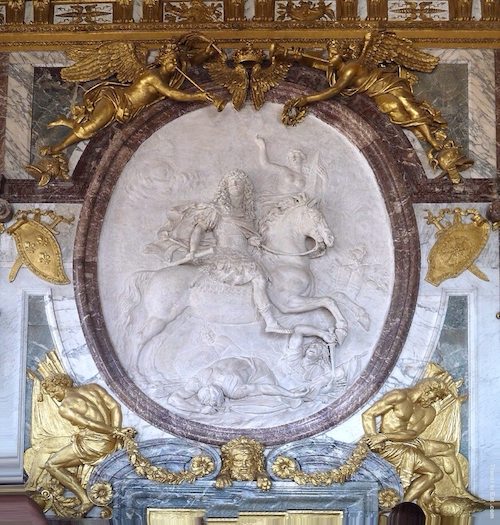
Mansart started to build the Salon de la Guerre (War Room) in 1678. The decoration, completed by Le Brun in 1686, glorifies the military victories that led to the Peace of Nijmegen. The walls are covered with marble panels decorated with six trophies and gilded bronze carvings. The wall on the Apollo Room side has an oval plasterwork bas-relief representing Louis XIV on horseback trampling over his enemies, seen above. This masterpiece by Coysevox is surmounted by two gilded Renommées supported by two prisoners in chains.

The ceiling, which was painted by Le Brun, represents France in the centre, armed and sitting on a cloud, surrounded by Victories. A portrait of Louis XIV decorates her shield. The other ceiling panels (not shown) portray the king’s three conquered enemies: Germany, kneeling, with an eagle; Spain, threatening, with a roaring lion and Holland, upside down on a lion. The fourth panel represents Bellone, Goddess of war, enraged between Rebellion and Discord.
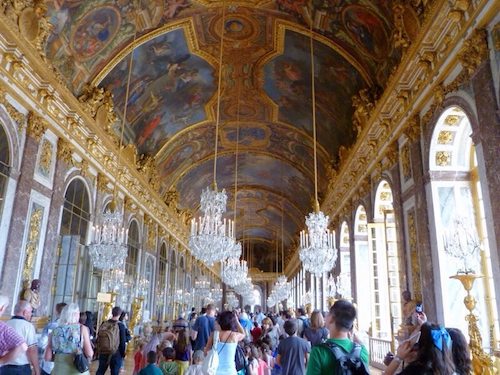
The Grand Gallery (La Grande Gallerie or Gallarie des Glaces in French), as it was called in the 17th century, served daily as a passageway and a waiting and meeting place, frequented by courtiers and the visiting public. The 220 foot-long-gallery was built between 1668 and 1690 by Jules Hardouin Mansard. In the middle of the room is the door to the King's apartments. The ceiling decoration is dedicated to the political policies and military victories of Louis XIV. The central panel of the ceiling, Le roi gouverne par lui-même (The king governs alone) alludes to the establishment of the personal reign of Louis XIV in 1661. It was also here that the treaty of Versailles was signed on 28th June 1919, which sealed the end of the First World War. Between 2007 and 2010 a 16 million dollar restoration was performed by the French company BTP Vinci, as a public service. Seventy percent of the mirrors date back to the original construction. During restoration of the ceiling, it was found that the notes on the paintings were recorded by none other than the playwright Racine and the poet Nicolas Boileau.
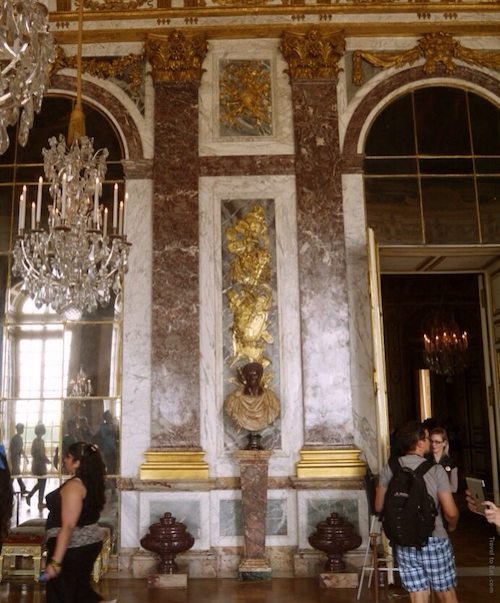
To understand the hall of mirrors and in fact the plethora of mirrors in the Palace of Versailles, we need a little historical perspective. Polished metal mirrors from Egypt, Greece and Rome can be found in museums around the world. What we understand as a modern mirror, a piece of glass with a reflective metal-foil backing, came into being sometime around the end of the 15th century. In Venice the development of cristallo, a transparent, colorless glass, gave Venetian glassmakers an advantage in the creation of high-quality mirrors with clear reflectance. Del Gallo glassmakers of the Venetian island of Murano improved the method by developing a mercury-tin amalgam technique for mirroring the glass surface.

Originally molten glass was blown and spun into a cylinder that was cut into a rectangular sheet, yielding a plate no larger than four-by-two feet. The plate was then ground smooth and flat with fine abrasives. A thin sheet of tin, slightly larger than the plate of glass, was laid on a table and covered with mercury. This was then applied to the back of the glass and weights were added to seal it to the glass. Finally, over the course of a month, the glass was gradually raised at an angle, allowing the excess mercury to run out. This process was time consuming and extremely expensive, yielding only small mirrors. It was also very toxic to the workers, as mercury is a lethal poison.
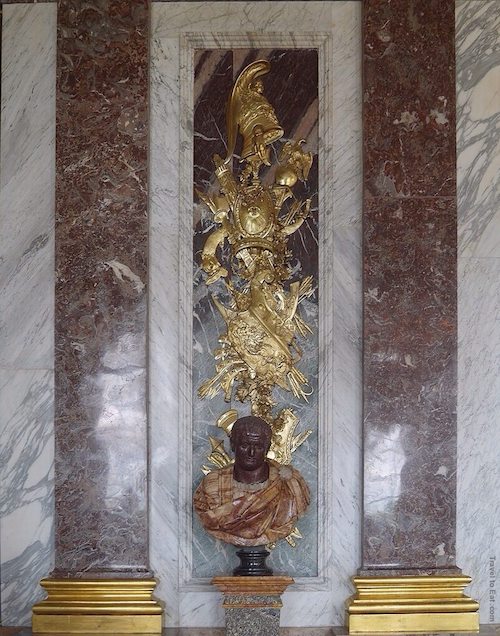
The process of mirror making was kept as a state secret and monopolized by Venetian Republic in the 17th century. In order to minimize the costs and enhance the process of mirror making to furnish the Palace of Versailles Hall of Mirrors, Jean Baptiste Colbert, French Minister of Finance at that time, employed several Venetian workers to start manufacturing this rare product in France. Legend has it that the Venetian Republic soon sent secret agents whose mission was to poison the workers to save the secret of mirror-making technology. The French improved the process with the glass-casting method, allowing glassmakers to achieve plates measuring up to nearly 9×5 feet. Thus the large mirrors in the palace represent a significant technological leap and because of the time and labour required, a massive statement of wealth, perhaps more than all the gold in the room. The three hundred and fifty-seven mirrors that decorate the seventeen arches opposite the windows, showed that the new French production of mirrors, which at the time were luxury objects were now a French commodity.
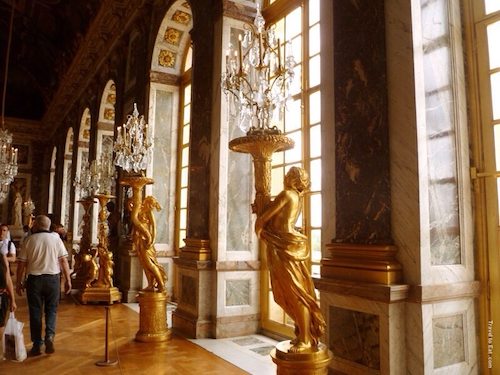
Today, the word “guéridon” describes any small round occasional table. When they were first introduced in 17th-century Europe, guéridons were typically one-legged pedestals or statues used as stands for candles or candelabra. They would often be positioned in front of mirrors as they are in the hall of mirrors so the candlelight could be reflected and multiplied in the glass. The original guéridons in the Gallerie des Glaces were solid silver, but they were melted down in 1689, to defray the cost of the War of the League of Augsburg. These gilded wood guéridons came in two versions (look carefully above), the female figures holding the horn of cornucopia by Pierre-Edme Babel and the cherubs holding up a torchiere by Touissant Foliot. Originally, before electricity, 3000 candles illuminated the hall.
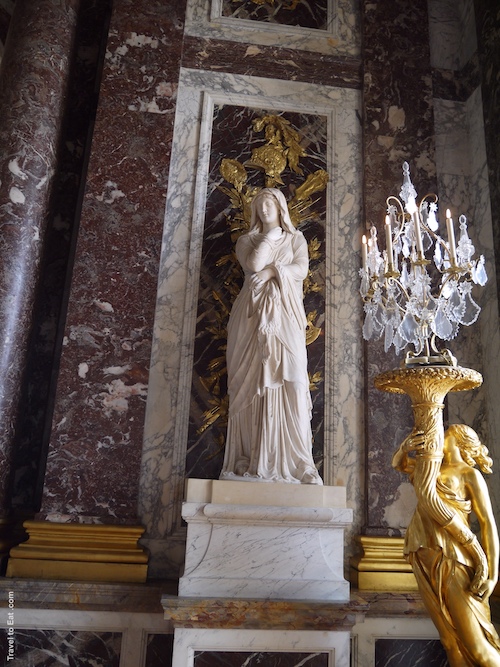
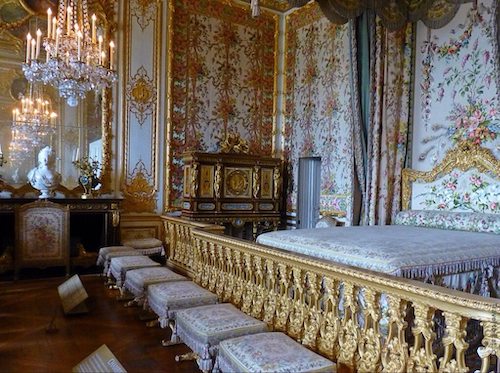
This is the Queen's bedchamber. It was designed by Robert de Cotte and Jacques V'th Gabriel between 1730 and 1735. On the fireplace in griotte marble with chased bronzes by Etienne Forestier (1786) is a bust of Marie Antoinette by Felix Lecomte from 1786. In the corner is the Queen's jewel box in mahogany, mother-of-pearl and gilded bronze by Jean-Ferdinand Schwerdfeger in 1787. The hidden door in the corner leads to the Queen’s internal apartments, a dozen small rooms reserved for her private life and her servants. This is where Marie Antoinette escaped in 1789 as the rioting crowds invaded the palace. The silks of the bed and alcove were woven in Lyon from the original cartoons. In front of the bed are eight seats from the countess of Artois's bedroom, the queen's sister-in-law. During the Revolution the palace was not looted, but the furniture was sold at auctions which lasted a whole year. Some items were found, such as the Schwerdfeger jewel case or the fire screen, others were replaced by equivalent pieces: this applies to the chairs, partly supplied to the Countess of Provence, the Queen’s sister-in-law and partly for the visit of the King of Sweden, Gustav III. The bed and balustrade were resculpted from the old documents.

The chamber is the main room of the apartment, the one where the Queen spent most of her time. She slept here, often joined by the King. In the morning, she received here during and after her Toilette, which constituted a Court event as regulated by etiquette as the Lever du Roi (Rising of the King). It was here, too, that births took place in public, nineteen “Children of France” were born here.

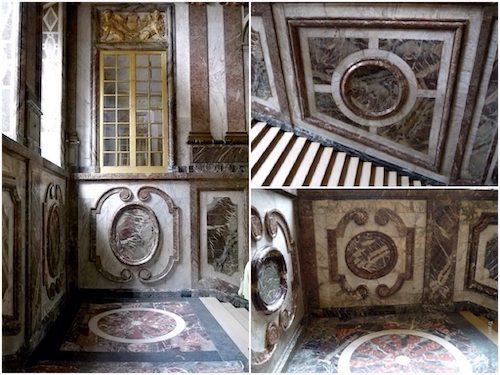
The Queen's Staircase (Marble Staircase or l'Escalier de Marbre) of multi- colored marble, with gilded bronze reliefs on the ceiling fillet and over the doors, leads into the queen's state and private apartments. In a recess on the first floor landing is the king's coat of arms, seen above. It was here that on October 6 1789, at dawn, the women who came to demand bread from the King, attempted to reach the Queen’s apartments, before a chambermaid, warned by a bodyguard, bolted the door of the Grand Couvert and advised the Queen to run away. Retracing their steps, they then tried to penetrate through the King’s Guard room.
In the 700 rooms of the Château de Versailles there are: 551,219 square feet of floor space, 67 staircases, 6,000 paintings, 2,100 sculptures, 5,000 items of furniture and 2,153 windows. The Estate of Versailles is larger than the island of Manhattan.
In 1685 more than 36,000 workers and 6000 horses were involved in the project, and when the building was completed 50 years later, it could accommodate up to 5,000 people, including servants. About 14,000 soldiers and servants were quartered in annexes and in the nearby town.
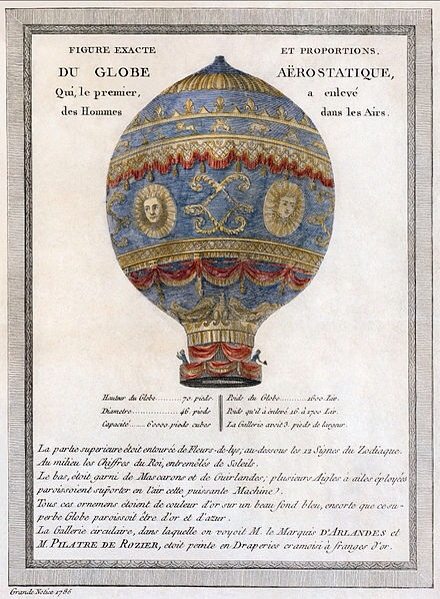
In 1783 the Montgolfier brothers conducted an experiment at Versailles, the first hot air ballon flight in history. Later, in December 1783, in recognition of their achievement, their father Pierre was elevated to the nobility and the hereditary appellation of de Montgolfier by King Louis XVI of France.
References:
Versailles Website: http://m.en.chateauversailles.fr/discover-estate
The Story of Versailles: http://www.gutenberg.org/files/14857/14857-h/14857-h.htm
The Hall of Mirrors: History & Restoration By Antoine Amarger, Christine Albanel: http://books.google.com/books?id=gGT92AT0_vwC&pg=PA87&lpg=PA87&dq=Gu%2525C3%2525A9ridons+versailles&source=bl&ots=FB_zxhNdxN&sig=xuv55wK2taXIUpFYmqOlYsp-4us&hl=en#v=onepage&q&f=false
Passports Versallies: http://www.passports.com/CityFacts/cityfact.cfm?city=Le%20Château%20de%20Versailles:%20Walking%20Tour

